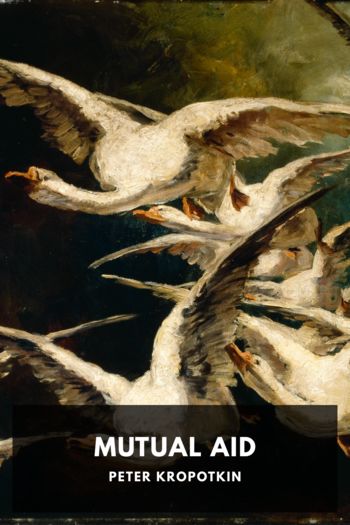Mutual Aid, Peter Kropotkin [fiction novels to read .txt] 📗

- Author: Peter Kropotkin
Book online «Mutual Aid, Peter Kropotkin [fiction novels to read .txt] 📗». Author Peter Kropotkin
Mr. Sutherland does not specify which “anecdotes” he means, but it seems to me that he could never have had the opportunity of perusing the works of Huber and Forel. Naturalists who know these works find no “anecdotes” in them.
The recent work of Professor Gottfried Adlerz on the ants in Sweden (Myrmecologiska Studier: Svenska Myror och des Lefnadsförhâllanden, in Bihan till Svenska A kademiens Handlingar, Bd. xi, No. 18, 1886) may be mentioned in this place. It hardly need be said that all the observations of Huber and Forel concerning the mutual-aid life of ants, including the one concerning the sharing of food, felt to be so striking by those who previously had paid no attention to the subject, are fully confirmed by the Swedish professor (pp. 136–137).
Professor G. Adlerz gives also very interesting experiments to prove what Huber had already observed; namely, that ants from two different nests do not always attack each other. He has made one of his experiments with the ant, Tapinoma erraticum. Another was made with the common Rufa ant. Taking a whole nest in a sack, he emptied it at a distance of six feet from another nest. There was no battle, but the ants of the second nest began to carry the pupae of the former. As a rule, when Professor Adlerz brought together workers with their pupae, both taken from different nests, there was no battle; but if the workers were without their pupae, a battle ensued (pp. 185–186).
He also completes Forel’s and MacCook’s observations about the “nations” of ants, composed of many nests, and, taking his own estimates, which brought him to take an average of 300,000 Formica exsecta ants in each nest, he concludes that such “nations” may reach scores and even hundreds of millions of inhabitants.
Maeterlinck’s admirably written book on bees, although it contains no new observations, would be very useful, if it were less marred with metaphysical “words.”
III Nesting AssociationsAudubon’s Journals (Audubon and His Journals, New York, 1898), especially those relating to his life on the coasts of Labrador and the St. Lawrence river in the thirties, contain excellent descriptions of the nesting associations of aquatic birds. Speaking of “The Rock,” one of the Magdalene or Amherst Islands, he wrote:—“At eleven I could distinguish its top plainly from the deck, and thought it covered with snow to the depth of several feet; this appearance existed on every portion of the flat, projecting shelves.” But it was not snow: it was gannets, all calmly seated on their eggs or newly-hatched brood—their heads all turned windwards, almost touching each other, and in regular lines. The air above, for a hundred yards and for some distance round the rock, “was filled with gannets on the wing, as if a heavy fall of snow was directly above us.” Kittiwake gulls and foolish guillemots bred on the same rock (Journals, vol. i, pp. 360–363).
In sight of Anticosti Island, the sea “was literally covered with foolish guillemots and with razorbilled auks (Alca torva).” Further on, the air was filled with velvet ducks. On the rocks of the Gulf, the herring gulls, the terns (great, Arctic, and probably Foster’s), the Tringa pusilla, the seagulls, the auks, the Scoter ducks, the wild geese (Anser canadensis), the red-breasted merganser, the cormorants, etc., were all breeding. The seagulls were extremely abundant there; “they are for ever harassing every other bird, sucking their eggs and devouring their young;” “they take here the place of eagles and hawks.”
On the Missouri, above Saint Louis, Audubon saw, in 1843, vultures and eagles nesting in colonies. Thus he mentioned “long lines of elevated shore, surmounted by stupendous rocks of limestone, with many curious holes in them, where we saw vultures and eagles enter towards dusk”—that is, Turkey buzzards (Cathartes aura) and bald eagles (Haliaëtus leucocephalus), E. Couës remarks in a footnote (vol. i, p. 458).
One of the best breeding-grounds along the British shores are the Farne Islands, and one will find in Charles Dixon’s work, Among the Birds in Northern Shires, a lively description of these grounds, where scores of thousands of gulls, terns, eider-ducks, cormorants, ringed plovers, oystercatchers, guillemots, and puffins come together every year. “On approaching some of the islands the first impression is that this gull (the lesser black-backed gull) monopolizes the whole of the ground, as it occurs in such vast abundance. The air seems full of them, the ground and bare rocks are crowded; and as our boat finally grates against the rough beach and we eagerly jump ashore all becomes noisy excitement—a perfect babel of protesting cries that is persistently kept up until we leave the place” (p. 219).
IV Sociability of AnimalsThat the sociability of animals was greater when they were less hunted by man, is confirmed by many facts showing that those animals who now live isolated in countries inhabited by man continue to live in herds in uninhabited regions. Thus on the waterless plateau deserts of Northern Tibet Prjevalsky found bears living in societies. He mentions numerous “herds of yaks, khulans, antelopes, and even bears.” The latter, he says, feed upon the extremely numerous small rodents, and are so numerous that, “as the natives assured me, they have found a hundred or a hundred and fifty of them asleep in the same cave” (Yearly Report of the Russian Geographical Society for 1885, p. 11; Russian). Hares (Lepus Lehmani) live in large societies in the Transcaspian territory (N. Zarudnyi, Recherches zoologiques dans la contrée Transcaspienne, in Bull. Soc. Natur. Moscou, 1889, 4). The small Californian foxes, who, according





Comments (0)